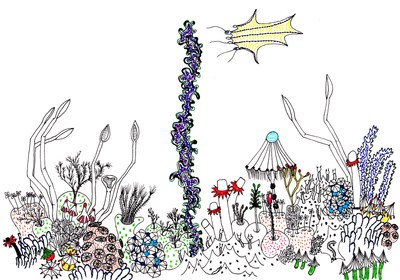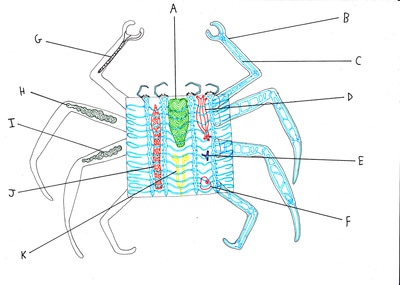|
The Conceptual Evolution Forum is where you can connect with other speccers, posting about your own projects and commenting on others. Get feedback on aesthetics and scientific plausibility from thousands of people all over the world. There are different sections to discuss future evolution on Earth, what might have happened on Earth had evolution run differently, evolution on other planets, and other universes where the laws of physics are different. Popular projects include Nemo and Sagan4. Register and say hello.
0 Comments
Illuria is the name of a planet with its own wiki that anyone can edit. According to the introduction, it was discovered in 3018, has a 48-hour day, and a year that is 730 Earth-days long.
In addition to mountains, deserts, scrublands, savannahs, temperate forests, rainforests, marshes, and prairies, it has acid swamps and the “mineral sea,” a body of water rich in iron, gold, and silver. Its sub-biomes include rust reefs, crystal caves, and wiregrass meadows. Among the animals of Illuria are crystal borers, shrimp-like, colonial animals that make nests out of crystals. Among the plants of Illuria are crawling boom creepers, plants that grow rapidly at night on stored fuel, seeking out sleeping animals to infect with its spores, which it often delivers so explosively that the animal is killed. As of this writing, the ecosystem is still incomplete. The life on the continents is undescribed. The gold shiners eat shellfish that have no page of their own. The hovizards lay their eggs on stilt plants with no page of their own. Visit and add your own ideas. Evolution is a board game of strategy. Each of 2-6 players maintains one or more species that feed from a shared watering hole. To remain alive through the player’s turn each species must take in enough food for their body sizes and population sizes. Those that do not go extinct. Phenotype cards can be combined to alter each species to make it better at getting food. Sometimes, this means becoming a carnivore that can only attack other species for food. Some traits include defenses against predation. When the card stack is empty, the game is over and the player with the most food wins. I want to play this sometime.
Species is less of a video game than an evolution simulation program. One can simply sit back and watch creatures adapt and speciate or one can introduce selection pressures to see what happens. Challenge yourself to evolve something resilient. Among other things, players can change the oxygen levels, temperature, sea levels, and radiation. Changes in terrain can force creatures to expend more calories in order to move. Specific attributes can be added to the gene pools of any population, including not only shape and color, but sex drive, the maximum genetic distance allowable for successful mating, and metabolism – affecting secondary traits such as how often they sleep and how much food they need to keep from going extinct. The software tracks phylogenetic history to produce cladograms and comes with a DNA toggle board. It looks awesome.
There are many awesome artists on DeviantArt.com, but not all of them have well-defined exobiology projects. Some focus on the behaviors and outside appearance of long-extinct organisms on Earth. Some engage in all kinds of art and mix all their work together. Some post great alien pictures, but give no descriptions or environmental context. Some deal more in fantasy than science fiction. Some only had a few good ideas and then stopped. Some create strange landscapes covered in what might possibly be plants perhaps inspiring someone else to offer design and explanation. Here are those that at least deserve recognition as artists:
Demmmmy is the creator of Fentil, an Earth-like planet of higher gravity and thicker air. It is the flora of planet Fentil I am most enamored with. There are plants that grow at the top, creating gigantic basket-like structures. There are plants that breathe. There is good fauna, too. There are the complex skeletons of the Dystroma and the complex vascular systems of the Photonimals. They are both highly creative and surprisingly plausible.
Spore is a computer game of five levels. First, the player creates a unique aquatic microbe that must survive the hardships of nature. Continual tweaks can help it to better thrive in its environment. Next, it becomes a land-based creature. Next, it develops social groups. Next, it develops technology. Finally, it colonizes space and this level is played against other empire-builders online. I can’t rate it because I’ve never played – I don’t have time or patience to learn structured games – but it sounds fun.
|
Like alien art? Check out my store.
Copyright © 2017



 RSS Feed
RSS Feed